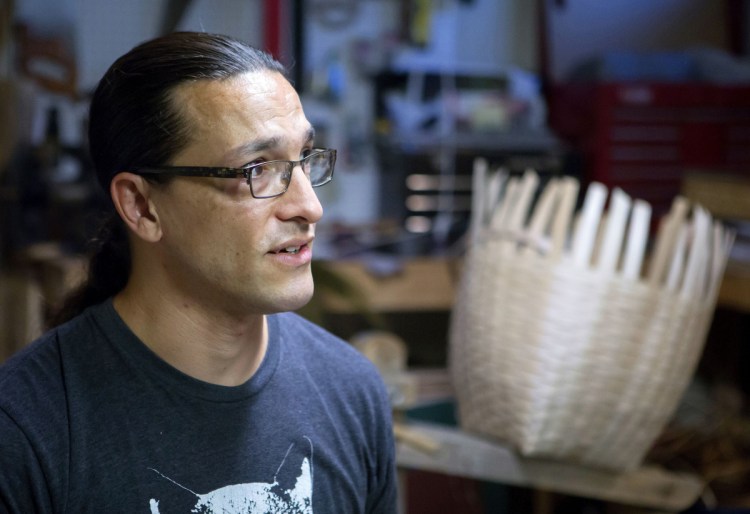Gabriel Frey, a Passamaquoddy basketmaker from Orono known for adding flourishes of color, leather and other notes of personal expressions to traditional Indian work baskets, is the latest Maine artist to win a prestigious United States Artists fellowship, which comes with a $50,000 prize.
Frey, 38, joins a growing number of artists from Maine who have won the honor in the past decade, including his brother Jeremy, who won in 2010, also for his work as a basketmaker.

With the prize money, Gabriel Frey will have more flexibility to buy leather or other materials as needed and not only when he has a surplus of income, he said.
“It’s huge,” Frey said of winning the fellowship. “It’s the difference between creating art to support my art habit and creating freedom to enact some of my ideas and inspirations.”
Other U.S. Artists fellowship recipients from Maine are Warren Selig of Rockland, who received a fellowship last year; Lauren Fensterstock and Anna Hepler, who both won in 2016; Portland ceramic artist Ayumi Horie; former Maine poet laureate Wesley McNair; novelist Annie Proulx; and Jeremy Frey. The award honors artists for career accomplishment and ongoing creative excellence.
The cash prize is unrestricted, which means Frey can use the money as he wishes. For an artist juggling a passion for art with a day job in an unrelated field, an award like this can change the direction of a life and career, he said. In addition to his work as a basketmaker, which he does in the basement of his home, Frey works as a massage therapist.
“I’m supporting my family and trying to pay a mortgage and keep food on the table through my day job plus my (art) work. There’s very little wiggle room to reinvest in an idea you want to create. You have to create what you know is going to make money,” he said.
With the money, he will feel more flexibility to buy leather or other materials as needed and not only when he has a surplus of income. His art career has been in a steady ascent over 20 years, with recent momentum building in his favor thanks to his winning key awards at national Indian markets and exhibitions. The U.S. Artists fellowship will help sustain that momentum and open up new opportunities, he said.
The award comes at a time when Indian basketmakers from Maine, and Maine’s Indian art traditions in general, are receiving more attention, said David Schultz, owner of the Arctic and Indian art gallery Home & Away in Kennebunkport and author of the book “Baskets of Time.”

Gabriel Frey’s work has won first-place honors at the Santa Fe Indian Market in New Mexico, the largest and most prestigious indigenous art fair in the country.
Frey has won first-place honors at the Santa Fe Indian Market in New Mexico, the largest and most prestigious indigenous art fair in the country, and is among a generation of Maine-based basketmakers who are bringing home national honors and attention. In addition, the Abbe Museum, which nominated Frey for the fellowship, has begun hosting an international Indian art market in May at its Bar Harbor campus.
“This honor that Gabriel has won is another example that shows how the work that is being done by the Wabanaki people, which has been a local or regional craft for generations, has finally been recognized nationally right alongside the top artists of all kinds,” Schultz said.
Frey said his success and that of his peers is in part because of the work of the Maine Indian Basketmakers Alliance, which formed in the mid-1990s to encourage passing along basketmaking traditions from generation to generation. At the time, there were fewer than a dozen weavers statewide younger than 50. Now, the average age of the 100-plus weavers in Maine is closer to 40.
The Frey brothers are among the younger stars, along with Sarah Sockebeson, Geo Neptune and others, who are considered modern masters. The Maine Crafts Association, in association with the Maine Arts Commission, recently named Gabriel Frey as a participant in the 2019 master-apprentice program. He will serve as a master to apprentice Frances Soctomah of Old Town. Soctomah apprenticed with her grandmother, Molly Neptune Parker, and hopes to expand her skills and learn new techniques studying with Frey.
Frey learned basketmaking from his grandfather, whom he moved in with at age 18. His mother, Gal Frey of Indian Township, is also a basketmaker.
Schultz said the Frey brothers make very different styles of baskets. Jeremy’s work is rooted in the fancy basket tradition, whereas Gabriel’s baskets come from the work-basket tradition, which he enhances with his use of color achieved through natural dyes, leather, silver and other adaptations that push the art form.
In a phone interview, Gal Frey said she was proud of all of her sons – another son, Joshua, makes his living working with granite – and deflected any credit for their success as individuals or collectively.
“I didn’t play any role, except being their mom,” she said. “They’re all equally good people. They’re equally good fathers and husbands, and they have a good base to operate from. They are just great people who didn’t fear to follow their dreams. … I don’t know if proud is a big enough word to describe how I feel.”
Bob Keyes can be contacted at 791-6457 or at:
bkeyes@pressherald.com
Twitter: pphbkeyes
Send questions/comments to the editors.




Comments are no longer available on this story